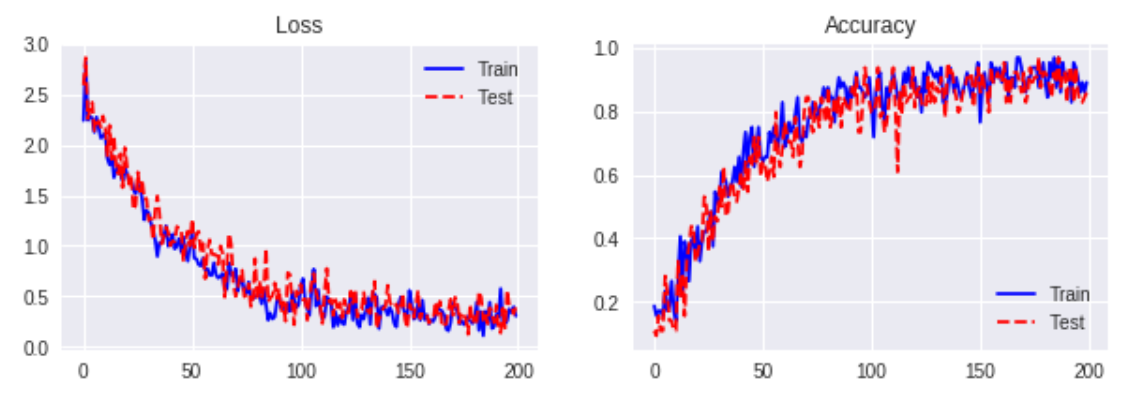ポイント
- LSTMをベースに Zoneout を実装。MNIST 手書き数字データでパフォーマンスを検証。
レファレンス
1. Zoneout: Regularizing RNNs by Randomly Preserving Hidden Activations
検証方法
(参照論文より引用)
データ
MNIST handwritten digits
from tensorflow.examples.tutorials.mnist import input_data
mnist = input_data.read_data_sets('***/mnist', \
one_hot = True)
検証結果
数値計算例:
- n_units = 100
- learning_rate = 0.1
- batch_size = 64
- zoneout_prob = 0.2
Zoneout ( no gradient clipping )

Zoneout ( clipped by norm, 0.5 )
サンプルコード
def get_zoneout_mask(self, zoneout_prob, shape):
keep_prob = tf.convert_to_tensor(zoneout_prob)
random_tensor = keep_prob + tf.random_uniform(shape)
binary_tensor = tf.floor(random_tensor)
zoneout_mask = binary_tensor
return zoneout_mask
# Zoneout
def inference(self, x, length, n_in, n_units, n_out, \
batch_size, forget_bias, zoneout_prob):
x = tf.reshape(x, [-1, length, n_in])
h = tf.zeros(shape = [batch_size, n_units], \
dtype = tf.float32)
c = tf.zeros(shape = [batch_size, n_units], \
dtype = tf.float32)
list_h = []
list_c = []
with tf.variable_scope('lstm'):
init_norm = tf.truncated_normal_initializer(mean \
= 0.0, stddev = 0.05, dtype = tf.float32)
init_constant1 = tf.constant_initializer(value = \
0.0, dtype = tf.float32)
init_constant2 = tf.constant_initializer(value = \
0.1, dtype = tf.float32)
w_x = tf.get_variable('w_x', shape = [n_in, n_units \
* 4], initializer = init_norm)
w_h = tf.get_variable('w_h', shape = [n_units, \
n_units * 4], initializer = init_norm)
b = tf.get_variable('b', shape = [n_units * 4], \
initializer = init_constant1)
zoneout_mask_c = self.get_zoneout_mask(zoneout_prob, \
[n_units])
zoneout_mask_complement_c = tf.ones(shape = \
[n_units], dtype = tf.float32) - zoneout_mask_c
zoneout_mask_h = self.get_zoneout_mask(zoneout_prob, \
[n_units])
zoneout_mask_complement_h = tf.ones(shape = \
[n_units], dtype = tf.float32) - zoneout_mask_h
for t in range(length):
t_x = tf.matmul(x[:, t, :], w_x)
t_h = tf.matmul(h, w_h)
i, f, o, g = tf.split(tf.add(tf.add(t_x, t_h), b), \
4, axis = 1)
i = tf.nn.sigmoid(i)
f = tf.nn.sigmoid(f + forget_bias)
o = tf.nn.sigmoid(o)
g = tf.nn.tanh(g)
# zoneout
c_temp = tf.add(tf.multiply(f, c), tf.multiply(i, g))
h_temp = tf.multiply(o, tf.nn.tanh(c))
c = zoneout_mask_c * c + \
zoneout_mask_complement_c * c_temp
h = zoneout_mask_h * h + \
zoneout_mask_complement_h * h_temp
list_h.append(h)
list_c.append(c)
with tf.variable_scope('pred'):
w = self.weight_variable('w', [n_units, n_out])
b = self.bias_variable('b', [n_out])
y = tf.add(tf.matmul(list_h[-1], w), b)
y = tf.nn.softmax(y, axis = 1)
return y

